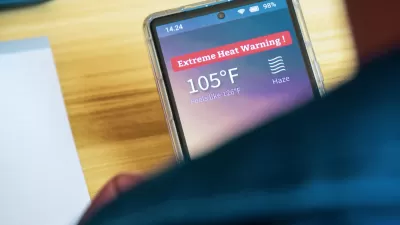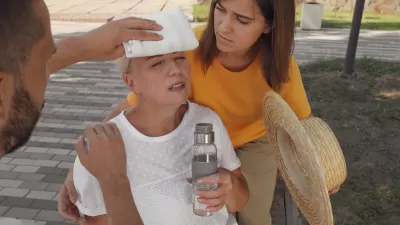The guide contains actionable steps local and state governments can take to protect vulnerable residents from the impacts of extreme heat.

As policymakers at all levels of government are beginning to recognize the significant threat posed by extreme heat, particularly to vulnerable populations such as children and the elderly., the U.S. Department of Housing and Urban Development (HUD) issued an Extreme Heat Playbook designed to help cities understand the public health risks of extreme heat and provide best practices for building resilience and mitigating the impacts.
According to a press release from HUD, “The Extreme Heat ‘Playbook’ is an actionable guide for planning and implementing measures, emphasizing evaluating existing community strengths, weaknesses, and capabilities; updating policies and protocols to address current and future conditions; lowering cooling costs; and highlighting the critical importance of resilience amid climate change, given the increase of severe extreme heat events.”
The guide identifies 16 strategies, complete with examples and a list of federal funding sources and resources. “Built upon four clear action tracks, the playbook includes multiple strategies within each section and provides project profiles that illustrate how other communities have addressed the impacts of extreme heat.”
The press release adds, “The ‘Playbook’ aligns with the National Heat Strategy introduced by the Biden-Harris Administration to coordinate a ‘whole-of-government’ approach to extreme heat from 2024 through 2030, as well as the newly-launched Extreme Heat Call to Action and the White House Climate Resilience Framework.”
FULL STORY: HUD Commits to Protect Households Across the Nation from Extreme Heat

Alabama: Trump Terminates Settlements for Black Communities Harmed By Raw Sewage
Trump deemed the landmark civil rights agreement “illegal DEI and environmental justice policy.”

Planetizen Federal Action Tracker
A weekly monitor of how Trump’s orders and actions are impacting planners and planning in America.

The 120 Year Old Tiny Home Villages That Sheltered San Francisco’s Earthquake Refugees
More than a century ago, San Francisco mobilized to house thousands of residents displaced by the 1906 earthquake. Could their strategy offer a model for the present?

In Both Crashes and Crime, Public Transportation is Far Safer than Driving
Contrary to popular assumptions, public transportation has far lower crash and crime rates than automobile travel. For safer communities, improve and encourage transit travel.

Report: Zoning Reforms Should Complement Nashville’s Ambitious Transit Plan
Without reform, restrictive zoning codes will limit the impact of the city’s planned transit expansion and could exclude some of the residents who depend on transit the most.

Judge Orders Release of Frozen IRA, IIJA Funding
The decision is a victory for environmental groups who charged that freezing funds for critical infrastructure and disaster response programs caused “real and irreparable harm” to communities.
Urban Design for Planners 1: Software Tools
This six-course series explores essential urban design concepts using open source software and equips planners with the tools they need to participate fully in the urban design process.
Planning for Universal Design
Learn the tools for implementing Universal Design in planning regulations.
Clanton & Associates, Inc.
Jessamine County Fiscal Court
Institute for Housing and Urban Development Studies (IHS)
City of Grandview
Harvard GSD Executive Education
Toledo-Lucas County Plan Commissions
Salt Lake City
NYU Wagner Graduate School of Public Service





























